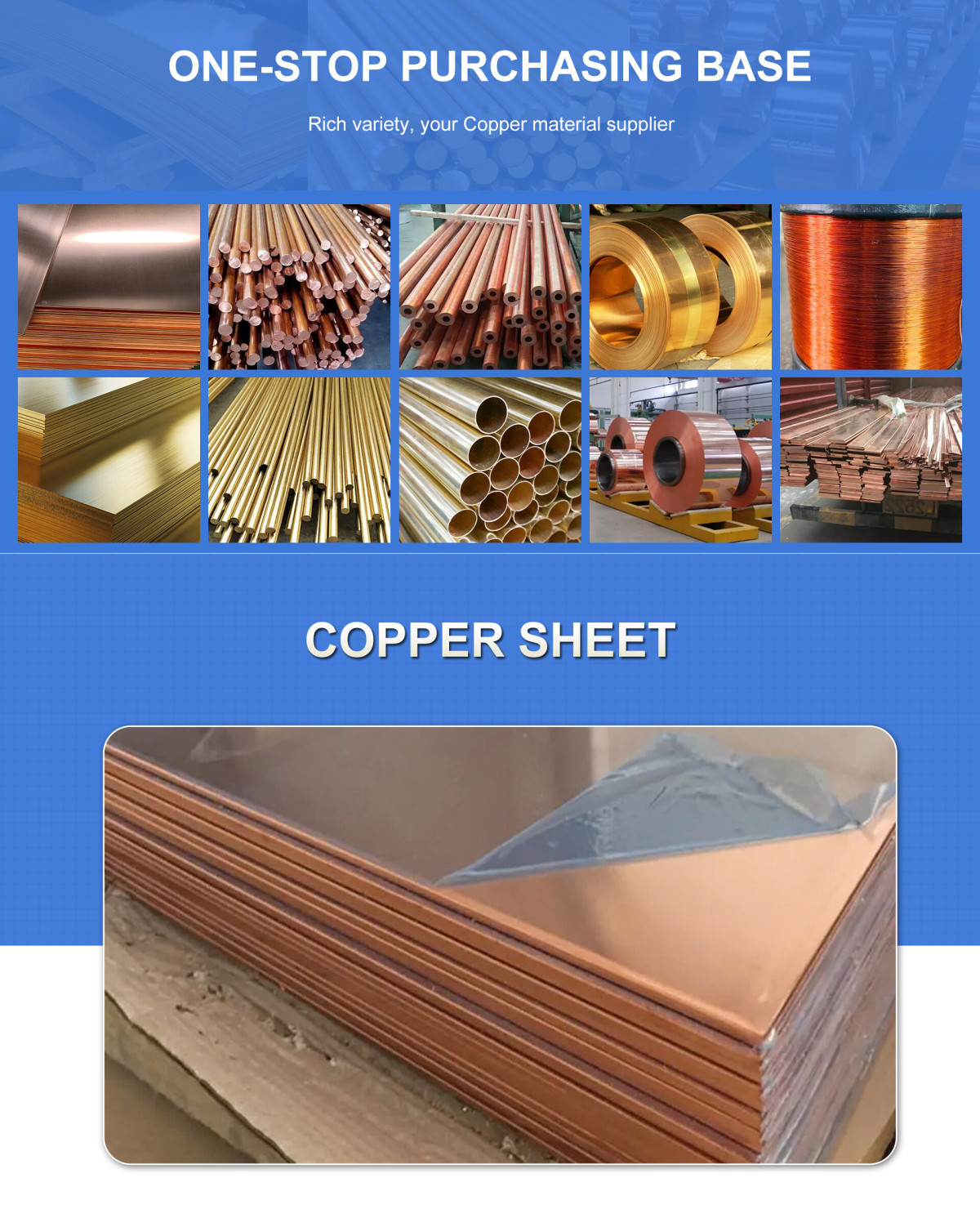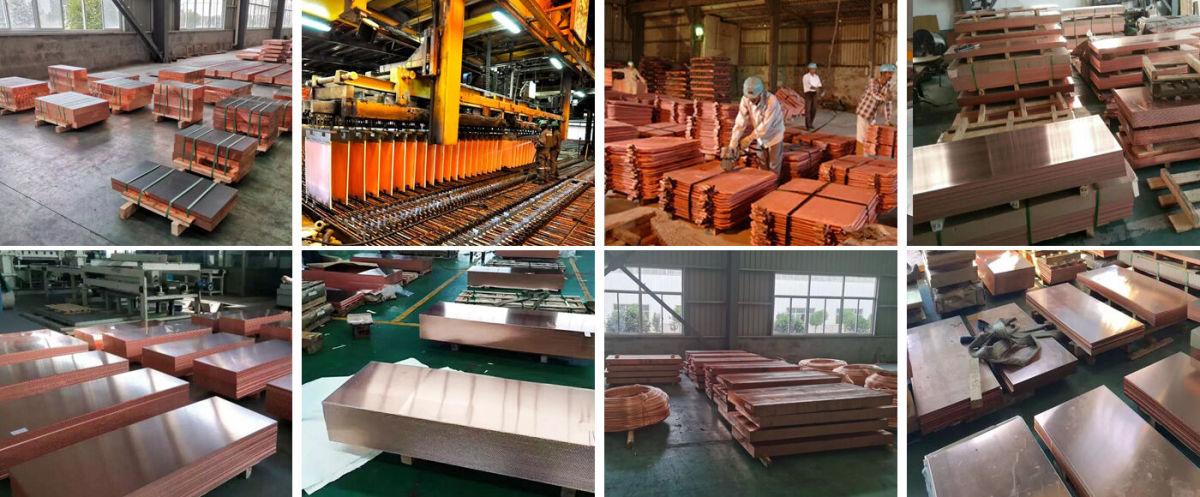
The general thickness range is 1.0-100mm (such as plates for mechanical parts), and specific applications may involve more detailed ranges, such as 1.3mm, 1.6mm, 1.8mm, 3.2mm, etc. for engraving plates.
The thickness of environmentally friendly soft copper plates can reach 1.0-1.6mm (in line with EU standards). Width and length can be customized
International Standards and Specifications
ASTM Standards:
ASTM B36: Applicable to soft annealed (O60 state) copper strip and plate of C23000 for general industrial use.
ASTM B152: Covers technical parameters such as tensile strength (≥195MPa) and elongation (≥30%) of copper strip.
European Standards (EN):
BS EN 13599:2014: Specifies the composition, electrical conductivity (≥100% IACS), thickness (0.05-25mm) and width (10-1250mm) of copper plates for electrical use, and includes tolerance requirements.
Chinese Standards (GB/T):
GB/T 2059: Requirements for thickness tolerance (±0.012mm), mechanical properties (such as tensile strength ≥195MPa) and surface quality of copper strip.
GB/T 17793—2010: Specifies the allowable deviation of the dimensions of copper strip, including width, length, straightness, etc.
Other standards:
DIN 17660: German brass alloy standard, covering the chemical composition and properties of CuZn15 (corresponding to C23000).
ISO 426-2: International general standard for copper-zinc alloys.
Main components:
Copper (Cu): The content ranges from 84.0% to 86.0%.
Zinc (Zn): As a residual component, it usually accounts for about 14%-16%.
Trace elements:
Lead (Pb): The maximum content does not exceed 0.05%.
Iron (Fe): The maximum content does not exceed 0.05% (some standards such as GB/T 5231-2012 stipulate that Fe≤0.03%)
Mechanical properties vary depending on processing status, hardness level and product size:
Tensile strength:
H01 (semi-hard): Minimum tensile strength for bars with diameters less than 1/2 inch is 305 MPa (44 ksi), and for bars with diameters greater than 1 inch is 275 MPa (40 ksi).
H02 (semi-hard): 345 MPa (50 ksi) for bars with diameters less than 1/2 inch, and 275 MPa (40 ksi) for bars with diameters greater than 1 inch.
H04 (hard): 435 MPa (63 ksi) for bars with diameters less than 1/2 inch, and 400 MPa (58 ksi) for bars with diameters greater than 1 inch.
Combined with other standards, the tensile strength range can reach 269-724 MPa (39-105 ksi).
Yield Strength:
Wide range, from 69 MPa (10 ksi) to 480 MPa (70 ksi), depending on processing
Elongation:
Up to 55% (2-inch gauge length), elongation for different hardness grades in ASTM standards varies with diameter.
Hardness:
Rockwell B hardness ranges from 48-87, Rockwell Superficial 30T hardness ranges from 51-77; hardness values vary in different annealing states.
Other Parameters:
Modulus of Elasticity: Approximately 110-117 GPa.
Poisson's Ratio: 0.33-0.34.
Shear Strength: 220-340 MPa.

Production process and product advantages of C23000 copper plate/copper strip:
1. Production process
Smelting process
Use submerged flow transfer technology to eliminate traditional flow troughs, reduce metal liquid cooling and smoke emissions, and improve energy efficiency. At the same time, apply micro rare earth element smelting technology to improve material properties and increase yield rate.
Casting technology
Horizontal continuous casting or vertical continuous casting technology: increase the yield rate by 5% and reduce casting defects.
Submerged nitrogen protection horizontal continuous casting: reduce oxidation, improve material uniformity, and is suitable for high-precision copper strip production.
Rolling process
Hot rolling: adopt large ingot rolling and thickness closed-loop control technology to increase coil weight and increase rolling speed, reducing unit energy consumption.
Cold rolling: Combine AGC closed-loop thickness control with roller technology to improve dimensional accuracy; continuous extrusion cold rolling process has the advantages of energy saving and high material utilization, and is suitable for medium and thick plate production.
Annealing and surface treatment
Use high hydrogen atmosphere expansion annealing or low temperature and low tension continuous annealing technology to optimize the mechanical properties of materials and reduce energy consumption.
Surface passivation process and acid purification technology: improve corrosion resistance and surface finish.
Finishing process
Includes stretching and straightening, degreasing and passivation, mechanized packaging and other links to ensure the flatness and quality stability of the finished product.
2. Product advantages
Excellent mechanical properties
Tensile strength ≥315MPa, elongation ≥25% (δ10) or ≥30% (δ5), with high strength and good plasticity, can withstand hot and cold pressure processing.
Through component uniformity control (Cu 84-86%, Zn margin) and residual stress optimization, reduce the tendency of stress corrosion cracking.
Processing and use performance
Easy to weld, forge and tin, suitable for complex molding needs.
Excellent electrical/thermal conductivity, resistant to atmospheric and fresh water corrosion, suitable for environments such as condensers and radiators.
High precision and consistency
Strict tolerance control and high-end surface finish meet the stringent requirements of ultra-thin and high-conductivity materials in automotive electronics, 5G communications and other fields.
Environmental protection and energy-saving characteristics
Green processes (such as online degreasing and low-temperature annealing) are adopted, and smoke emissions are much lower than traditional methods, which is in line with the trend of circular economy.
The yield rate is increased by 10%, and the energy consumption per unit product is significantly reduced.
Q1:Do you provide samples? Is it free or extra?
A1:Yes, we can provide samples free of charge and the customer will pay the freight.
Q2:What if I don't have export experience ?
A2:We have reliable forwarder agent which can ship items to you by sea/air/Express to your doorstep. Any way, we will help you choose the most suitable shipping service.
Q3:How long is your lead time?
A3:If it is in stock, it is usually 5-10 days. Or, if there is no inventory, 15 days, depending on the quantity.
Q4:What are your terms of payment?
A4:30% T/T deposit in advance, 70% T/T balance within 5 days after B/L copy, 100%.Irrevocable L/C at sight, 100% Irrevocable L/C after receive B/L 30-120 days, O/A.
Q5:How is your technical support?
A5:We provide lifetime online support through Whatsapp/ Skype/ Wechat/ Email. Any problem after delivery, we will offer you call anytime.
Welcome To Your Inquiry
What can we help you?
RELATED PRODUCTS








